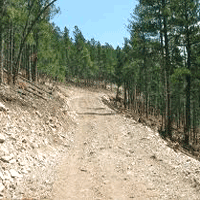
Impact of rainfall intensity and cutslope material on sediment concentration from forest roads in northern Iran
Saeed Rahbari Sisakht (1) , Baris Majnounian (1), Mohsen Mohseni Saravi (2), Ehsan Abdi (1), Christoper Surfleet (3)
iForest - Biogeosciences and Forestry, Volume 7, Issue 1, Pages 48-52 (2014)
doi: https://doi.org/10.3832/ifor0097-007
Published: Oct 21, 2013 - Copyright © 2014 SISEF
Research Articles
Abstract
Forest roads are important for adequate management of natural resources, but they are also a dominant contributor of sediment to forest streams and water pollution. This study measured road sediment concentration from forest roads to determine the impact of rainfall intensity and cutslope types on sediment concentration in the Patom district of northern Iran. Two 110 m road segments with variable soil and rock fragment cover exposed at the cutslopes were studied. Seven rainfall and corresponding runoff events were measured in 1-liter bottle samplers every 10 minutes at the outlet of cross sectional culverts, and from two 3 m2 plots on the roadbeds adjacent to each cutslope. A statistically significant difference at the 95% confidence level between two cutslope types and rainfall intensity on sediment concentration was determined from the field data based on nonparametric tests, though no statistically significant difference in the concentration of sediment between the two roadbeds plots were found. The average of sediment concentration of soil trench and the rock fragment cover cutslopes were 60.3 and 46.8 g/l, respectively. The results reported here should help forest road managements to improve the understanding of cutslopes erosion and sediment production from forest roads and to employ suitable methods to reduce sediment production.
Keywords
Forest Road, Cutslope, Rainfall Intensity, Rock Fragment, Sediment Concentration
Authors’ Info
Authors’ address
Baris Majnounian
Ehsan Abdi
Forestry and Forest Economics Department, Faculty of Natural Resources, University of Tehran, Karaj (Iran)
Range and Watershed Management Department, Faculty of Natural Resources, University of Tehran, Karaj (Iran)
Department of Forest Engineering, Resources and Management College of Forestry, Oregon State University, Corvallis, OR (USA)
Corresponding author
Paper Info
Citation
Rahbari Sisakht S, Majnounian B, Mohseni Saravi M, Abdi E, Surfleet C (2014). Impact of rainfall intensity and cutslope material on sediment concentration from forest roads in northern Iran. iForest 7: 48-52. - doi: 10.3832/ifor0097-007
Academic Editor
Roberto Tognetti
Paper history
Received: Mar 14, 2012
Accepted: Apr 08, 2013
First online: Oct 21, 2013
Publication Date: Feb 03, 2014
Publication Time: 6.53 months
Copyright Information
© SISEF - The Italian Society of Silviculture and Forest Ecology 2014
Open Access
This article is distributed under the terms of the Creative Commons Attribution-Non Commercial 4.0 International (https://creativecommons.org/licenses/by-nc/4.0/), which permits unrestricted use, distribution, and reproduction in any medium, provided you give appropriate credit to the original author(s) and the source, provide a link to the Creative Commons license, and indicate if changes were made.
Web Metrics
Breakdown by View Type
Article Usage
Total Article Views: 55247
(from publication date up to now)
Breakdown by View Type
HTML Page Views: 46853
Abstract Page Views: 2931
PDF Downloads: 4104
Citation/Reference Downloads: 14
XML Downloads: 1345
Web Metrics
Days since publication: 4435
Overall contacts: 55247
Avg. contacts per week: 87.20
Citation Metrics
Article Citations
Article citations are based on data periodically collected from the Clarivate Web of Science web site
(last update: Mar 2025)
Total number of cites (since 2014): 5
Average cites per year: 0.38
Publication Metrics
by Dimensions ©
Articles citing this article
List of the papers citing this article based on CrossRef Cited-by.
References
Water quality management for pond fish culture. Elsevier Scientific Pub. Co., pp. 318.
Gscholar
Cross-drain placement to reduce sediment delivery from roads to streams. MS Thesis, University of Washington, Seattle, WA, USA, pp. 207.
Gscholar
Problems in measuring and modeling the influence of forest management on hydrologic and geomorphic processes. In: “Land use and watersheds: human iInfluence on hydrology and geomorphology in urban and forest areas” (Wigmosta MS, Burges SJ eds). American Geophysical Union, Washington, DC, USA, pp. 77-83.
Gscholar
Stream hydrology an introduction for ecologists (2 edn). John Wiley and Songs Ltd., UK, pp. 423.
Gscholar
Mass movement response to forest management in the central Oregon Cost ranges. Resource Bulletin PNW-84, USDA Forest Service, Portland, USA, pp. 26.
Gscholar
Forest roads: a synthesis of scientific information. Gen. Technol. Rep. PNW-GTR-509, USDA Forest Service, Portland, USA, pp. 120.
Gscholar
Determination of most effective factor on sediment production due to road in forest mountainous roads. Journal of Applied Science 10 (9): 1069-1076.
Gscholar
Road sediment production and delivery: processes and management. In: Proceedings of the “First World Landslide Forum. International Program on Landslides and International Strategy for Disaster Reduction”. United Nations University, Tokyo, Japan, pp. 381-384.
Gscholar
Middle east watershed monitoring and evaluation project: accuracy and associated with erosion monitoring using sediment traps. [Unpublished Report].
Gscholar
Personal communication and unpublished data of turbidity threshold measurements for Oak Creek Roads. Oregon State University, Corvallis, Oregon State, USA.
Gscholar
Soil erosion by water and conservation. University of Tehran, Tehran, Iran, pp. 671.
Gscholar
Forest soils in Kheiroudkenar forests. Natural Resources Journal (special Issue), pp. 103
Gscholar
Uncertainty in forest road hydrologic modeling and catchment scale assessment of forest road sediment yield. PhD thesis, Oregon State University, Corvallis, OR, USA, pp. 276.
Gscholar
Soil losses from roadbeds and cut and fill slopes in the southern application mountains. Southern Journal of Applied Forestry 8: 209-215.
Gscholar

















